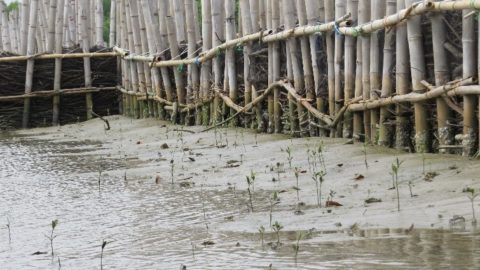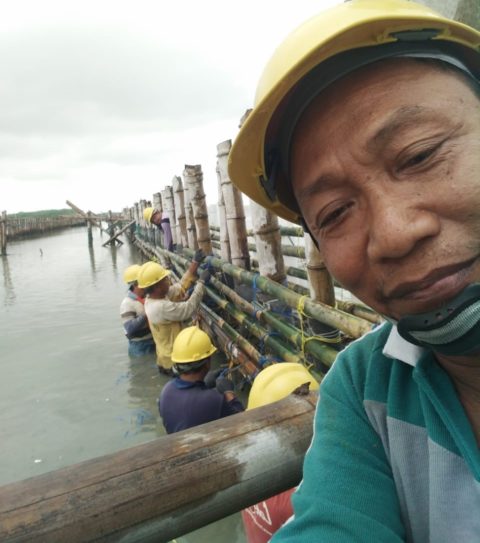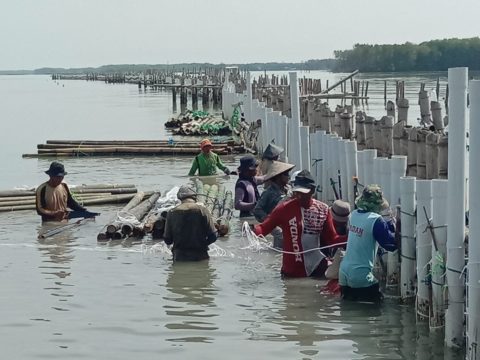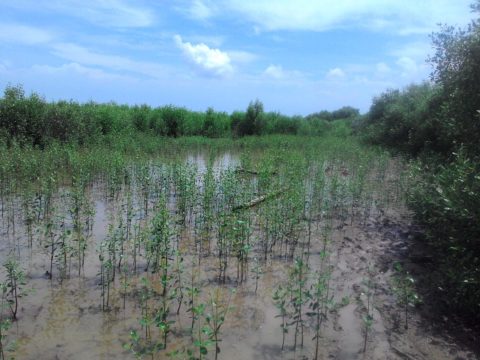
Communities manage permeable structures to restore mangroves in Java
-
Aquaculture, fisheries and coastal agriculture
-
Coastal resilience
-
Coastal wetland conservation
The restoration of a mangrove green belt in muddy coastal areas suffering from erosion and abrasion can be done through, among others, construction of permeable structures. The Building with Nature Indonesia Consortium transferred the ownership of permeable structures built so far from local contractors to the communities. This is key in view of sustainability beyond the project lifetime. Placement of new structures and maintenance are now entirely carried out by the community.
The function of those permeable structures is to capture sediment that will function as a substrate for mangroves to grow naturally. Since 2015, the Building with Nature (BwN) program has been building permeable structures, together with locally-formed community groups, in three villages in Demak District, namely Bedono, Timbulsloko, and Surodadi.

To date, cumulatively 4.7 km of permeable structures have been constructed and maintained. Some structures were abandoned as the site conditions turned out to be unsuitable, other structures had to be rebuilt due to problems with durability. Hence, in total ~1.8 km of the structure remains in place, behind which we expect ~20 ha of mangrove to be restored.
In the first three years (2015-2017) the construction and maintenance of permeable structures were done through local contractors that were asked to engage with Building with Nature community group members. This was done to ensure that group members understand the construction and maintenance process, and to foster a sense of belonging.
In July 2018, the structures and continuation of their maintenance were handed over to the community groups, which was further handed over to the local village government. Since then, maintenance of existing structures and the construction of new structures has become the duty of community groups.

Through ‘Biorights agreements’ community groups provide their time for maintenance as an in-kind contribution, while the BwN program contributes in the form of provision of materials, logistics, and technical advice. In return, the Biorights mechanism provides communities with (financial) incentives for sustainable aquaculture and other livelihood development alongside a range of mangrove restoration measures. The maintenance work carried out by community groups includes routine monitoring of physical conditions, required repairs, and protection of the structures, the trapped sediment and the recovered mangroves from potential disruption and damage.

It is expected that maintenance work can be carried out more effectively by the communities than by the contractors because community members can perform monitoring every day and take necessary actions immediately. Also, as part of the Biorights program, communities are assisted to reach out to village and district government, already resulting in enhanced village regulations and government support for e.g. maintenance of permeable structures, mangrove rehabilitation and aquaculture which is encouraging in view of sustainability beyond the project lifetime.
“The permeable structures are very beneficial for Timbulsloko village, because they function as both sediment retainer and wave barrier, and therefore reduce the impacts of abrasion. The sediment captured becomes a substrate for mangroves, of which a whole belt along the coast would benefit not only the community but also the ecosystem and the environment. Therefore, it is important for us to ensure that the permeable structures are always in good condition to be able to carry out their functions properly”, said Mat Sairi, Chair of the Barokah community group, Timbulsloko Village.
In our 2017 report on Integrated Water Resources Management (IWRM), we signaled that land subsidence is likely even more severe than we thought, reaching up to 8 cm a year and stretching along the entire Demak coast. The subsidence has several causes, among which groundwater extraction by (bio-)industry in and around Semarang and Demak city is most important. It is not yet clear whether sediment trapping through permeable structures can keep up with this level of subsidence and we need to follow the situation closely. Due to the severity of subsidence, we may have reached a threshold where coastal restoration and aquaculture revitalisation may no longer be feasible at the landscape scale. Note that traditional infrastructural measures will also not be able to cope with such high subsidence levels.
Nonetheless, Building with Nature (BwN) measures will still enhance the resilience of the coastal communities and ecosystem in the shorter term and at a smaller scale, thus softening and delaying the impact of hazards. Even if erosion and flooding can in the longer term not be avoided, the BwN program can still help communities to adapt or transform their livelihoods.

Indeed, we note that the communities are awakening in response to the opportunities offered by the Coastal Field Schools and Biorights mechanism. Communities previously passively accepted the regular floodings and low productivity, while now they are more hopeful, creative and collaborative in making the best of the situation. We are also actively calling upon decision-makers to address the root causes of subsidence by initiating dialogues from local to national level.
This blog was developed by Eko Budi Priyanto, Kuswantoro, Didik Fitrianto, Apri Susanto Astra and Yus Rusila Noor, Wetlands International Indonesia
